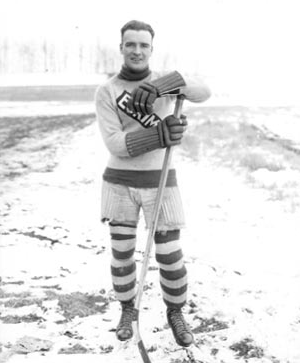IMAGE INFORMATION
EditHarold Edward Joseph "Bullet Joe" Simpson - Born August 13, 1893 in Selkirk, Manitoba – Died December 25, 1973 in Coral Gables, Florida was a Canadian Ice Hockey defenceman and coach and manager.
The nickname "Bullet Joe" comes from being such a fantastic, fast skater who regularly made incredible end-to-end rushes, and was known for firing bullet shots from center-ice at opposing goaltenders. It was also a reference to the wounds he suffered in WWI.
Simpson started his career in the Canadian west. He learned the sport of ice Hockey on a frozen slough, near his house, during the early 1900s. As Bullet Joe once stated, Manitoba Avenue ran east and west in the middle of Selkirk. The boys living in the north end were the northern team and those south of Manitoba Avenue made up the southern team.
After graduating from the Selkirk Fishermen Juniors, Simpson played senior ice hockey with the Winnipeg Victorias of the NHA in 1914–15.
Prior to enlisting in the Canadian Army for World War I he captained the 1916 Allan Cup Champions 61st Overseas Battalion Team of Winnipeg. During the war he served with the 43rd Cameron Highlanders and his unit held part of the British front alongside a battalion commanded by Major Winston Churchill. Bullet Joe was wounded twice during the war, once at the Battle of the Somme, and once at Amiens. He received the Medal of Military Valour.
Simpson returned home in February 1919 having achieved the rank of lieutenant. He was in time to play in the last four games of the ice Hockey season for his home town, Selkirk Fisherman Seniors of the Manitoba Seniors League. He started again for the Seniors the following year.
In 1920, at 5'10" and 175 pounds, this right-handed defenceman's break came in a Winnipeg pool room when Kenny MacKenzie of the Big 4's Edmonton Eskimos offered Bullet Joe $3,000 to turn professional. Upon hearing the offer, he chalked his cue and replied that if MacKenzie could sell the deal to his father then Edmonton would have themselves an ice Hockey player. Edmonton got their player and Bullet headed off to join the Eskimos in 1920, signing as a free agent on November 4.
In 1921–22, he was a Western Hockey League first team all-star berth. He was named to the first team on three occasions and to the second team once. At that time, Newsy Lalonde called Bullet Joe Simpson the greatest living Hockey player. His end-to-end rushes were legendary and without comparison.
When the Western Hockey League ceased operations at the end of the 1924–25 season, Simpson's contract was purchased by the New York Americans of the National Hockey League. Bullet Joe Simpson, John Morrison and Roy Rickey were traded September 18, 1925 for $10,000.
Bullet Joe made his NHL debut on November 16, 1926 vs Pittsburgh Pirates at Duquesne Garden in a 1-0 New York win.
Bullet Joe scored his 1st NHL goal vs John Ross Roach of the Toronto St. Patricks on December 4, 1926 at Arena Gardens in a 1-0 New York win. His goal was the game winner.
Bullet Joe played six seasons with New York and in 1931 took on the role of team coach for three years. He later managed/coached the New Haven and Minneapolis teams.
Bullet Joe played 228 regular season NHL games, scoring 21 goals (3 GWG), 19 assists and 2 NHL playoff games with 0 points.
Bullet Joe coached the Minneapolis Millers to the 1937 Harry F. Sinclair Trophy championship, as winners of the American Hockey Association / AHA. The Millers reached the finals again in 1938.
Simpson moved to Florida after the 1937-38 AHA season to promote ice Hockey. He later suffered a heart attack that kept him inactive for two years. Another retired ice Hockey player and Floridian came to his aid. Art Coulter hired him to work and sell ice skates at Coulter White's hardware store in Coral Gables Florida, which had a ice rink at the Miami Coliseum.
Bullet Joe Simpson was inducted into the Hockey Hall of Fame in 1963.
Bullet Joe Simpson was inducted into Canada's Sports Hall of Fame in 1975.
Harold Edward "Bullet Joe" Simpson was inducted into the Manitoba Hockey Hall of Fame in 1985.
Bullet Joe Simpson was inducted into the Manitoba Sports Hall of Fame in 2013.
In 1994, the Marine Museum of Manitoba in Selkirk restored a 1963 flat-bottomed freighter which is now on display and renamed the Joe Simpson.













